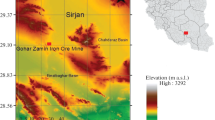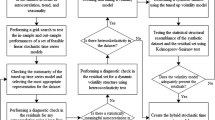Abstract
Time series techniques have been applied to a wide variety of academic fields, particularly in the fields of economics, environment, and hydrology. This research work deals with application of the time-lag multiple linear regression technique to predicting the groundwater level and salinity fluctuation in a saline but irrigated area in Northeastern Thailand. Regulating gates are constructed to prevent flooding of the river downstream and to provide the surrounding upstream areas with sufficient irrigation water. The technique is essentially based on the lagged correlation between leading variables, i.e. rainfall and river stages, and their corresponding responses, i.e. groundwater depth and salinity. While the rainfall is simulated with a multiple sinusoidal model, the river stage model comprises two components: a single sinusoidal component and a multiple linear regression component implemented with independent variables, i.e. rainfall, regulating gate outflow, and irrigation supply. The shallow groundwater and groundwater salinity fluctuation in the irrigated area are shown by cross-correlation analysis to be dependent upon the surface water regulation and prior rainfall and thus can be simulated by a multiple linear regression with lagged time dependence. Once properly calibrated and verified, the model can perform better matching to the observed data vis-à-vis the conventional multiple linear regression model. The proposed model can also be deployed for forecasting and management of the future groundwater system, especially in situations in which costlier and more complex numerical modeling techniques are inapplicable.









Similar content being viewed by others
References
Abdalla OAE, Al-Rawahi AS (2013) Groundwater recharge dams in arid areas as tools for aquifer replenishment and mitigating seawater intrusion: example of AlKhod. Oman Environ Earth Sci 69(6):1951–1962
Adhikary SK, Rahman M, Gupta AD (2012) A stochastic modeling technique for predicting groundwater table fluctuations with time series analysis. Int J Appl Sci Eng Res 1(2):238–249
Anderson MP, Woessner WW (1992) Applied groundwater modeling. Academic Press, San Diego
Bennett R (1979) Spatial Time Series. Pion, London
Berendrecht WL, Heemink AW, van Geer FC, Gehrels JC (2003) Decoupling of modeling and measuring interval in groundwater time series analysis based on response characteristics. J Hydrol 278:1–16
Box GEP, Jenkins GM (1976) Time series analysis: forecasting and control. Holden-Day, San Francisco
Caselli F, Esquivel G, Lefort F (1996) Reopening the convergence debate: a new look at cross-country growth empirics. J Econ Growth 1(3):363–389
Clean Water Team (CWT) (2004) Electrical conductivity/salinity Fact Sheet, FS-3.1.3.0 (EC). In: The Clean Water Team Guidance Compendium for Watershed Monitoring and Assessment, Version 2.0. Division of Water Quality, California State Water Resources Control Board (SWRCB), Sacramento, CA
Commonwealth Scientific and Industrial Research Organization (CSIRO) (2009) Groundwater yields in south-west Western Australia report to the Australian Government from the CSIRO south-west Western Australia sustainable yields project. Technical report, Australia
El-Din AG, Smith DW (2002) A combined transfer-function noise model to predict the dynamic behavior of a full-scale primary sedimentation tank. Water Res 36(15):3747–3764
Ferdowsian R, Pannell DJ, McCarron C, Ryder A, Crossing L (2001) Explaining groundwater hydrographs: separating typical rainfall events from time trends. Aust J Soil Res 39(4):861–875
Ferdowsian R, Ryser A, George R, Bee G, Smart R (2002) Groundwater level reductions under lucerne depend on the landform and groundwater flow systems (local and intermediate). Aust J Soil Res 40(3):381–396
Glamore W, Indraratna B (2001) The impact of floodgate modification on water quality in acid sulphate soil terrains. In: Barton ACT (ed) Coasts & Ports 2001: proceedings of the 15th Australasian Coastal and Ocean Engineering Conference, the 8th Australasian Port and Harbour Conference. Institution of Engineers, Australia, pp 265–270
Hammer Q, Harper DAT (2006) Paleontological data analysis. Blackwell, Oxford
Hammer Q, Harper DAT, Ryan PD (2001) PAST: paleontological statistics software package for education and data analysis. Paleontol Electron 4(1):1–9
Harper DAT (1999) Numerical paleobiology. John Wiley, Chichester
Hipel KW, McLeod AI (1994) Time series modeling of water resources and environmental systems. Elsevier, Amsterdam
Houston JFT (1983) Groundwater system simulation by time series techniques. Groundwater 21(3):301–310
Johnston SG, Slavich PG, Hirst P (2005) Opening floodgates in coastal floodplain drains: effects on tidal forcing and lateral transport of solutes in adjacent groundwater. Agric Water Manag 74(1):23–46
Kalff J (2002) Limnology. Prentice Hall, Upper Saddle River
Kim SJ, Hyun Y, Lee KK (2005) Time series modeling for evaluation of groundwater discharge rates into an urban subway system. Geosci J 9(1):15–22
Kroes JG, van Dam JC (2003) Reference Manual SWAP version 3.0.3. Alterra-report 773, Alterra, Research Institute, Wageningen, The Netherlands
Kumar CP (2012) Groundwater data requirement and analysis. Technical notes. National Institute of Hydrology, Roorkee
Lee CH, Chen WP, Lee RH (2006) Estimation of groundwater recharge using water balance coupled with base-flow-record estimation and stable-base-flow analysis. Environ Geol 51:73–82
Machiwal D, Jha MK (2011) Hydrologic time series analysis: theory and practice. Springer (2012 edn)
Machiwal D, Jha MK (2014) Characterizing rainfall-groundwater dynamics in a hard-rock aquifer system using time series, geographic information system and geostatistical modelling. Hydrol Process 28:2824–2843
Maiti S, Tiwari RK (2014) A comparative study of artificial neural networks, Bayesian neural networks and adaptive neuro-fuzzy inference system in groundwater level prediction. Environ Earth Sci 71(7):3147–3160
McLeod AI (1994) Diagnostic checking periodic autocorrelation models with applications. J Time Ser Anal 15:221–233
McLeod AI, Hipel KW (1978) Simulation procedures for Box-Jenkins models. Water Resour Res 14(5):969–975
Mondal MS, Wasimi SA (2005) Periodic transfer function-noise model for forecasting. J Hydrol Eng 10(5):353–362
Mondal MS, Wasimi SA (2006) Generating and forecasting monthly flows of the Ganjes River with PAR Model. J Hydrol 232:41–56
Montanari A, Rosso R, Taqqu MS (2000) A seasonal fractional ARIMA model applied to the Nile river monthly flows at Aswan. Water Resour Res 36(5):1249–1259
Neill JC (1980) Prediction of rainfall trends. State Water Survey Division, Illinois Institute of Natural Resources
Ogallo LAJ (1977) Periodicities and trends in the annual rainfall over Africa. Master’s Thesis, University of Nairobi
Panda DK, Mishra A, Jena SK, James BK, Kumar A (2007) The influence of drought and anthropogenic effects on groundwater levels in Orissa, India. J Hydrol 343:140–153
Peterson TJ, Western AW (2011) Time-series modeling of groundwater head and its decomposition to historic climate periods. The 34th IAHR World Congress, Brisbane, Australia
Renard P (2007) Stochastic hydrogeology: what professionals really need? Gr Water 45:531–541
Rodhe H, Virji H (1996) Trends and periodicities in East African rainfall data. Mon Weather Rev 104:307–315
Ropelewski CF, Halpert MS (1987) Global and regional scale precipitation patterns associated with El Nino/southern oscillation. Mon Weather Rev 115:1601–1626
Salas JD, Delleur JW, Yevjevich V, Lane WL (1980) Applied modeling of hydrologic time series. Water Resources Publication, Colorado
Seeboonruang U (2011) An investigation on the effect of groundwater and capillary rise on the salt ponds in Nakhon Panom province Thailand. AGU Fall Meeting 2011, San Francisco
Seeboonruang U (2014) Physico-chemical characterization of saline subsurface system near small endorheic ponds in Thailand. Environ Earth Sci 71(7):3273–3286
Soltani S, Modarres R, Eslamian SS (2007) The use of time series modeling for the determination of rainfall climates of Iran. Int J Climatol 27:819–829
Song SH, Zemansky G (2013) Groundwater level fluctuation in the Waimea Plains, New Zealand: changes in a coastal aquifer within the last 30 years. Environ Earth Sci 70(5):2167–2178
Soumya BS, Sekhar M, Riotte J, Banerjee A, Braun JJ (2013) Characterization of groundwater chemistry under the influence of lithologic and anthropogenic factors along a climatic gradient in Upper Cauvery basin South India. Environ Earth Sci 69(7):2311–2335
Stein EM (1993) Harmonic analysis. Princeton University Press, Princeton
Tankersley CD, Graham WD (1994) Development of an optimal control system for maintaining minimum groundwater levels. Water Resour Res 30:3171–3181
Tankersley CD, Graham WD, Hatfield K (1993) Comparison of univariate and transfer function models of groundwater fluctuations. Water Resour Res 29(10):3517–3533
Thailand Mineral Resource Department (TMRD) (1998) The study of salt rock in the Lower Namkam Basin irrigation project-Nakhon Panom province. Final Report, Thailand
Van Geer FC, Zuur AF (1997) An extension of Box–Jenkins transfer/noise models for spatial interpolation of groundwater head series. J Hydrol 192:65–80
Von Asmuch JR, Bierkens PF (2005) Modeling irregularly spaced residual series as a continuous stochastic process. Water Resour Res. doi:10.1029/2004WR003726
Von Asmuth JR, Knotters M (2004) Characterizing groundwater dynamics based on a system identification approach. J Hydrol 296:118–134
Wetzel RG (2001) Limnology: lake and river ecosystems. Academic Press, San Diego
Wildi W (2010) Environmental hazards of dams and reservoirs. http://www.unige.ch/sciences/near/pdf/Wildi%202010.pdf. Accessed 26 June 2013
Yi M, Lee K (2003) Transfer function-noise modeling or irregular observed groundwater heads using precipitation data. J Hydrol 288:272–287
Acknowledgments
This research has been fully funded by King Mongkut’s Institute of Technology Ladkrabang (KMITL). The result in the paper is part of the three-year project: “The Study of Soil and Water Resource Development for Saline Soil Area in Nam Kam Basin, Nakhon Panom Province”. Special thanks to all research assistants and colleagues in the Department of Civil Engineering, KMITL.
Author information
Authors and Affiliations
Corresponding author
Rights and permissions
About this article
Cite this article
Seeboonruang, U. An application of time-lag regression technique for assessment of groundwater fluctuations in a regulated river basin: a case study in Northeastern Thailand. Environ Earth Sci 73, 6511–6523 (2015). https://doi.org/10.1007/s12665-014-3872-7
Received:
Accepted:
Published:
Issue Date:
DOI: https://doi.org/10.1007/s12665-014-3872-7




